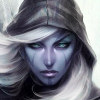Hriss
 Name: Hriss
Name: HrissGender: Female
Race: Naga, striker subtype
Class: Politician
Age: 29
Physical Age: 19
Length: 18 ft total, 5 ft 8 standing at usual height.
Weight: 482 pounds
Scale Color: Blue
Eye Color: Red
Complexion: N/A
Build: Lean
Blood Type: A+


Description: The Naga are humanoid reptilian species that are more qualified to describe them as snakes for them to have snake-like lower torso rather than legs. Live-bearing snakes and egg-laying snakes CAN interbreed, but there are qualifiers. If the mother is oviparous, eggs are laid. If the mother is of a species that bears live young, live young will be brought forth. In nagas egg-laying is dominant over live-bearing. Simple Punnett-square genetics will tell you how that plays out in female offspring. Males have no such problems, and their offspring are laid or born depending on the genes of the mother. Patterns are dominant over solids, and patterns are partly dominant among themselves, much like hair color. Instead of being one or the other, they tend to combine.
Non-venomous non-constrictors occasionally interbreed with either constrictors or venomous Nagas without too much fuss on either side. Constrictors and venomous nagas do not tend to interbreed as a general rule, but isnt unheard of. It has nothing to do with biology: purely the Yankees/Red Sox phenomenon. Ninety percent of the time, venomous-constrictor hybrid children have the constrictor clan apothecary as a parent, as the apothecary of the constrictor clans is always a hybrid or outclan venomous Naga, and is accepted as one of the clan the way another venomous Naga would not be.
Unlike snakes, Nagas actually raise their children, though occasionally they wonder if maybe their limbless cousins dont have the better idea. The average clutch size (or litter, if livebearing) is six. Incubation time varies from clan to clan, and it is always the female who incubates the eggs. This is because only females have the ability to shiver to generate heat. Males are dependent on sunning themselves to raise their body temperature, and that doesnt cut it where eggs are concerned. A newborn naga is small enough to fit in its parents hand, and has a pot-belly from the last of the yolk for about a week after hatching, at which point they have to be fed. Both parents raise the young.
Culture: For each species of snake, there is a species, or clan, of Naga. Subspecies (using rattlesnakes as an example, eastern diamondback and western diamondback) are merely different clans. They consider themselves the same kind of Naga, though occasionally it gets to be like Yankees and Red Sox. Each lives in an environment best suited to its corresponding species of snake, and tend to view snakes of a parallel species (rattlesnakes and rattlesnake nagas) as cousins. They do not eat snakes unless their species happens to eat snakes (bull snakes, etc).
General clan habits closely mirror the habits of the snake species they correspond to especially in times of day most active and when they best like to hunt. As said above, they live in environments very similar to those that best favor their corresponding snake though the Nagas tend to have a better tolerance of environments outside of that ideal than the actual snake would.
Most traits are dependent upon the individual clans, and many of them do not divide down neat lines like venomous and constrictor. For example, trickery. Among the venomous clans, the cobras are very fond of riddles, and consider themselves to have a noble bearing among hunters; the taipans are shy, vicious, and nasty to outsiders, and are quiet and mysterious; the cottonmouths and asps are downright tricksters; the coral snakes and rattlesnakes are brutally direct. Among non-venomous snakes, the bull snakes are very straightforward, with the brass and ability to back it up (in the wild, bull snakes frequently make a meal of their venomous cousins); and the hog-nose clan tends to try to bluff, hide, and misdirect even if theyre very bad at it (hognose snakes have been called wanna-be puff adders). The king snake clan, on the other hand, is very _good_ at bluffing. The same applies to the constrictor clans the anaconda clan likes to lie in wait for someone to do something stupid, the pythons are, by and large, opportunists, and the boa clans vary on directness from clan to clan, sometimes wildly.


